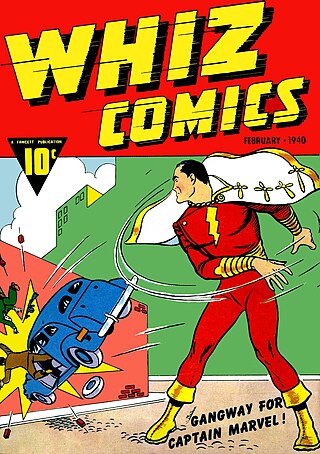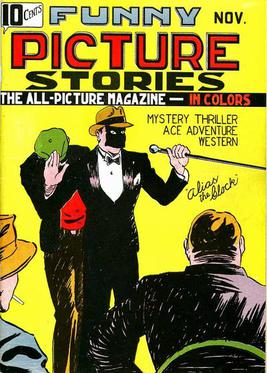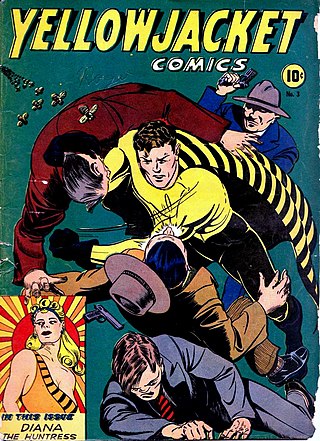Related Research Articles

A superhero or superheroine is a stock character who typically possesses superpowers or abilities beyond those of ordinary people, is frequently costumed concealing their identity, and fits the role of the hero; typically using their powers to help the world become a better place, or dedicating themselves to protecting the public and fighting crime. Superhero fiction is the genre of fiction that is centered on such characters, especially, since the 1930s, in American comic books, as well as in Japanese media.

Miss America is a superhero appearing in American comic books published by Marvel Comics. Created by writer Otto Binder and artist Al Gabriele, the character first appeared in Marvel Mystery Comics #49 in the Golden Age of Comic Books. Madeline Joyce is the first incarnation of Miss America. The character has also been a member of the Invaders, Liberty Legion, and All-Winners Squad at various points in her history.

Phantom Lady is a fictional superheroine appearing in media published by Quality Comics and DC Comics. She was created by the Eisner & Iger studio, one of the first to produce comics on demand for publishers. The character's early adventures were drawn by Arthur Peddy.

Bulletman and Bulletgirl are fictional superheroes originally published by Fawcett Comics.

The Clock is a fictional masked crime-fighter character created in 1936, during the Golden Age of Comic Books. He was the first fully-masked hero to appear in American comic books.

Cat-Man and Kitten are a pair of fictional superhero characters created by artists Irwin Hasen (Cat-Man) and Charles M. Quinlan (Kitten) with unknown writers. Cat-Man was first published in 1940 by various Frank Z. Temerson companies. Due to circumstances during World War II, an altered version of Cat-Man was published in Australia and reprinted in the 1950s. AC Comics later revived the characters in the 1980s.

Mr. Muscles is a fictional comic book superhero created in 1956 by writer Jerry Siegel for Charlton Comics, and drawn by Bill Fraccio for the first of two issues of his namesake comic, and by the team of penciler Charles Nicholas and inker Vince Alascia for the second. A young Dick Giordano provided the premiere issue's cover. Siegel, who co-created Superman, wrote both issues featuring Charlton's own muscleman.

Lady Luck is an American comic-strip and comic-book crime fighter and adventuress created and designed in 1940 by Will Eisner with artist Chuck Mazoujian. She starred in a namesake, four-page weekly feature published in a Sunday newspaper comics insert colloquially called "The Spirit Section", which ran from June 2, 1940, to November 3, 1946. Her adventures were reprinted in comic books published by Quality Comics. A revamped version of the character debuted in 2013 in DC Comics's Phantom Stranger comic.

The Blonde Phantom is a fictional masked crime fighter appearing in American comic books published by Marvel Comics. Created for Marvel predecessor Timely Comics by Stan Lee and Syd Shores, the character first appeared in All Select Comics #11, during the 1940s period fans and historians call the Golden Age of Comic Books. The heroine was so well received that the next issue was retitled The Blonde Phantom. The series continued to feature her until issue #22. She also appeared in backup stories in many other Timely comics; in Superhero Comics of the Golden Age, Mike Benton observes that "for a few months in 1948, readers could find her in seven titles on the newsstand." In The Supergirls, Mike Madrid asserted, "Once again, a capable woman hid behind a meek persona and only let her hair down, literally, to come to the aid of a man who completely ignored her unless she assumed a disguise. In a 1947 story entitled "I Hate Myself", Louise even dreams that Mark finally confesses his love for her, only to have the Blonde Phantom persona appear and steal him away."

Yellowjacket is a fictional super-hero, and the first to be published by the company that would become Charlton Comics. He first appeared in Yellowjacket Comics #1.

Wonder Boy is the name of two fictional characters who have appeared as superheroes in comics published by Quality Comics and DC Comics. The original was an alien who appeared in National Comics. The second was a time-traveler from an alternate future who appeared in Team Titans.
Hydroman is a fictional superhero character who first appeared in comic books from Eastern Color Printing in 1940.

Jester is a fictional character, a Golden Age superhero created by Paul Gustavson and published by Quality Comics. He first appeared in Smash Comics #22. Like most of Quality's characters, the Jester was later purchased by DC Comics and incorporated into their universe. Though little used by the company, he appeared in All-Star Squadron #31 and #60 and Starman #46. The character's last Golden Age appearance was in Smash Comics #85.

Wildfire is a fictional superhero in the DC Comics universe. One of the first female superheroes, she was originally published by Quality Comics during what comics historians and fans called the Golden Age of comic books. With her luxurious mane of red hair and revealing costume, she has been called "the sexiest super-hero of 1941".

The Bouncer is a fictional superhero who appeared in comic books published by Fox Feature Syndicate. The Bouncer had no secret identity, but was in reality a statue of the Greek mythological figure Antaeus. The statue had been sculpted by Adam Anteas, Jr., a descendant of the very same legendary figure. Like his Greek ancestor, Anteas Jr. gained power when in contact with the earth. Anteas Jr.'s power was that he bounced back whenever he struck the ground; the harder he hit, the higher he bounced. Like his ancestor, he lost his power when out of contact with the ground.

Samson is a superhero who appeared in comic books published by Fox Feature Syndicate. He first appeared in Fantastic Comics #1. The writer was uncredited, but is believed to be Will Eisner; the artist was Alex Blum, using the pseudonym "Alex Boon".

The Woman in Red is a fictional character that first appeared in the period known to comic book historians as the Golden Age of Comic Books. Created by writer Richard E. Hughes and artist George Mandel, she first appeared in Thrilling Comics #2, published by Nedor Comics. The character was later revived by writer Alan Moore for America's Best Comics. She would also be used by Dynamite Entertainment in Project Superpowers Chapter Two.

Fantomah is an American comics character, best known as one of the earliest comic-book superheroines. Created by Fletcher Hanks, the character first appeared in Jungle Comics #2, published by Fiction House. Hanks is also known for creating the equally strange Stardust the Super Wizard.

The Black Owl is the name of two fictional superhero characters. Both appeared in the Prize Publications title Prize Comics in the 1940s.
References
- 1 2 3 Koolman, Mike; Amash, Jim (2011). The Quality Companion. TwoMorrows Publishing. pp. 187–188. ISBN 978-1605490373.
- ↑ Markstein, Don. "The Spider Widow". Don Markstein's Toonopedia. Retrieved 18 March 2020.
- ↑ Yoe, Craig (2016). Super Weird Heroes:Outrageous But Real!. Yoe Books/IDW. p. 284. ISBN 978-1631407451.
- 1 2 Madrid, Mike (2016). The Supergirls: Fashion, Feminism, Fantasy and the History of Comic Book Heroines. Exterminating Angel Press. pp. 8, 304. ISBN 978-1-935259-33-6.
- ↑ Frankel, Valerie Estelle (2017). "Family Foils". Superheroines and the Epic Journey: Mythic Themes in Comics, Film and Television. McFarland and Co. p. 84. ISBN 9781476628011 . Retrieved 11 April 2020.
- ↑ Robbins, Trina (1996). The Great Women Superheroes. Kitchen Sink Press. p. 31. ISBN 9780878164820.
- ↑ Hill, Roger (2017). "Big Changes on the Horizon". Reed Crandall: Illustrator of the Comics. TwoMorrows Publishing. p. 98. ISBN 9781605490779 . Retrieved 10 April 2020.
- ↑ Morris, Jon (2018). The League of Regrettable Sidekicks: Heroic Helpers from Comic Book History!. Quirk Books. ISBN 978-1683690764.
- ↑ Mitchell, Kurt; Thomas, Roy (2019). American Comic Book Chronicles: 1940-1944. TwoMorrows Publishing. p. 221. ISBN 978-1605490892.
- ↑ Benton, Mike (1992). Superhero Comics of the Golden Age: The Illustrated History. Dallas: Taylor Publishing Company. p. 163. ISBN 0-87833-808-X . Retrieved 8 April 2020.
- ↑ Booker, M. Keith, ed. (2014). Comics Through Time: A History of Icons, Idols, and Ideas. ABC-CLIO. p. 138. ISBN 9780313397516.
- ↑ Benton, Mike (1992). Superhero Comics of the Golden Age: The Illustrated History. Dallas: Taylor Publishing Company. p. 177. ISBN 0-87833-808-X . Retrieved 8 April 2020.